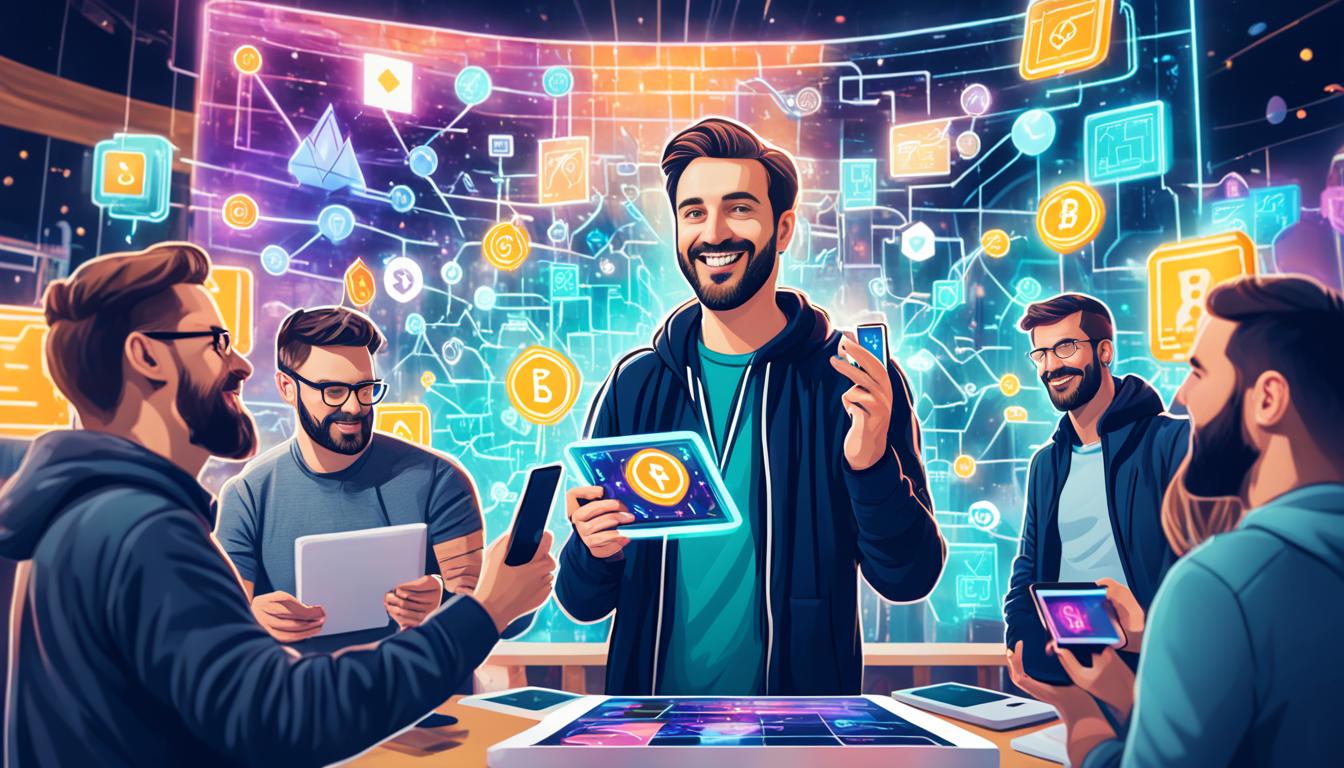NFTs (Non-Fungible Tokens): How to create, buy, sell, and invest in NFTs.
Ever thought about why a digital art piece could sell for millions? Or why people buy virtual items for a lot of money? This guide dives into the world of NFTs (Non-Fungible Tokens). It explains how these special digital items have grabbed worldwide attention. You’ll learn about their place in the digital investment scene.
Understanding NFT marketplaces might seem tricky because of the different fees, from 0% to 5% on secondary sales. OpenSea usually takes a 2.5% cut while Magic Eden and Rarible offer more flexibility. The market hit $41 billion in 2021, drawing a lot of interest. For example, Mike Winklemann sold his art for $69.3 million through Christie’s, showing how much people are willing to invest in NFTs.
Key Takeaways
- NFTs are unique digital assets recorded on blockchain technology, particularly Ethereum.
- NFT marketplaces such as OpenSea, Rarible, and NBA Top Shot each have distinct transaction fees and structures for buying and selling.
- Setting up your digital wallet with MetaMask, Coinbase Wallet, or Trust Wallet is crucial for NFT transactions.
- Noteworthy sales have fetched multi-million dollar amounts, showcasing the lucrative potential of investing in NFTs.
- Thorough research is vital due to the varying verification processes and potential risks associated with NFTs.
- The growing utility and investment opportunities in NFTs are redefining market efficiencies and ownership transfer processes.
What are NFTs (Non-Fungible Tokens)?
NFTs are unique digital items stored on a blockchain. They prove ownership digitally. Unlike Bitcoin or Ethereum, each NFT is special, making it one of a kind. NFTs are used in digital art, collectibles, and more, changing how we own and trade items online.
Understanding Blockchain Technology
The technology behind NFTs is blockchain. It’s a system that keeps a record of transactions without a central authority. Blockchain makes sure digital assets, like NFTs, are real. It uses codes to verify these digital items. The concept started with CryptoKitties, a game on Ethereum in 2017. Since then, NFTs have grown fast in many digital areas.
Types of NFTs
NFTs come in many forms. Crypto art is a favorite, with sales hitting high prices. There’s also digital collectibles, like the Bored Ape Yacht Club, in-game items, and event tickets. Let’s look closer at what NFTs can be:
- Digital Art: Unique digital creations you find on sites like OpenSea.
- Collectibles: Things like CryptoKitties and digital trading cards.
- In-game Items: Tools and skins you can find in games on the blockchain.
- Event Tickets: Special digital tickets for events, making entry secure.
Each type lets both the makers and buyers explore new ways to deal with digital goods.
Difference Between NFTs and Cryptocurrency
Even though NFTs and cryptocurrencies use the same technology, they are different. Cryptocurrencies are for trading or buying things. They’re all the same, like coins and bills. NFTs, on the other hand, are all about owning unique digital stuff. This can be anything from art to digital clothes.
| Comparison | NFTs | Cryptocurrencies |
|---|---|---|
| Nature | Non-fungible and unique | Fungible and interchangeable |
| Use Cases | Digital art, collectibles, event tickets | Transactions, payments, asset storage |
| Blockchain | Mostly Ethereum, also other blockchains | Bitcoin, Ethereum, others |
This explains how NFTs are a big deal in the digital world. They open new doors for owning and sharing digital stuff.
How to Create NFTs
Creating NFTs can be an exciting journey for digital creators. This guide will help you mint NFTs smoothly. It also focuses on adding value to your digital art.
Steps to Mint Your NFT
To begin minting NFTs, pick the right blockchain. Ethereum is a top choice, with ERC-721 and ERC-1155 standards for NFTs. Here are the steps after choosing your blockchain:
- Digitize Your Item: Ensure your digital content, like art or music, is ready for sharing.
- Select a Blockchain: Ethereum is popular, but you can also consider Solana or Flow for different perks.
- Choose a Marketplace: Sign up on a marketplace that works with your blockchain. Platforms like OpenSea, Binance, or NBA Top Shot are good options.
- Upload and Describe: Share your digital piece with a great title and description to attract buyers.
- Mint Your NFT: Add crypto tokens to your wallet for minting fees. Then, mint your NFT.
Choosing the Right Marketplace
Choosing the best marketplace is key for finding your audience and good trade terms. Platforms like OpenSea offer large exposure. Here’s a quick look at some options:
| Marketplace | Notable Features | Fees |
|---|---|---|
| OpenSea | Leading platform, supports Ethereum-based NFTs | 2.5% transaction fee |
| Binance | Lower fees, supports multiple blockchains | 1% platform fee |
| NBA Top Shot | Focused on sports collectibles, primarily on Flow blockchain | Varies |
Best Practices for Creating High-Value NFTs
To make valuable NFTs, think about these tips:
- High-Quality Content: Use top-quality images, sound, and video.
- Descriptive and Catchy Names: Good names and descriptions make NFTs more attractive.
- Ensure Originality: Always own the rights to your work.
- Engage with Your Audience: Talking to your audience can boost the value of your NFTs.
Follow these tips to navigate the NFT world. Use Ethereum and smart marketplace choices. This way, you can earn through your digital work with NFTs.
Where to Buy and Sell NFTs
Buying and selling NFTs is easy now, thanks to many online marketplaces. Each marketplace offers something different, meeting the needs of NFT fans and traders. We’ll look into some top NFT sites, how to get a digital wallet, and what fees to look out for.
Popular NFT Marketplaces
There are many places to choose from, depending on what you like. Some are more controlled, while others are more open.
- OpenSea: The biggest marketplace for crypto items and NFTs. It works on many blockchains and lets you completely control your items.
- Magic Eden: More than 90% of the trade happens here on some blockchains. It’s great for buying NFTs.
- Binance NFT: It has a low 1% fee and is easy to use, making it a top pick for many.
- Foundation: It’s famous for selling viral memes and digital art on the Ethereum blockchain.
- LooksRare: Makes trading better by offering quick payments for creators. It also has a reward system using LOOKS tokens.
Setting Up Your Digital Wallet
Start your NFT journey by creating a crypto wallet. It’s key to keep your digital items safe and to buy from places like OpenSea and Magic Eden. Here’s what you need to do:
- Choose a Wallet: You can pick from wallets like MetaMask and Coinbase Wallet.
- Install and Setup: Get the wallet app on your device and set it up as directed.
- Fund Your Wallet: Add cryptocurrency, mainly Ether (ETH), so you’re good to go.
Making sure your crypto wallet is ready is vital for good trading on websites like Binance NFT and more.
Transaction Fees to Consider
Know the costs involved in buying and selling NFTs. Different sites have different prices:
| Marketplace | Seller Fees | Buyer Fees | Additional Costs |
|---|---|---|---|
| OpenSea | 2.5% per transaction | – | Gas fees |
| Magic Eden | 2.5% | – | – |
| Binance NFT | 1% | – | – |
| Nifty Gateway | 5% | – | 3% flat transaction fee |
| SuperRare | 15% first sale, 3% subsequent | 3% | – |
Knowing the fees, including those for listing and possible royalties, helps buyers and sellers in the NFT world make smart choices.
Investing in NFTs
Exploring NFT investing means grasping market trends, associated risks and rewards, and potential top NFTs. These digital assets open up worldwide investment chances and sit in a unique spot within finance.
Understanding Market Trends
NFTs have become significant, making up $10 billion in sales by Q3 2021. Sites like OpenSea show that thousands are sold daily, appealing to gamers, collectors, and hobbyists. Sales like Beeple’s for $69 million and Kevin McCoy’s for over $1 million draw huge interest. Market analysis sees NFTs offering a worldwide investment option outside of crypto’s ups and downs.
Risks and Rewards
NFT investing offers exciting possibilities balanced by key risks. Benefits include shared ownership, easy transfer, and stronger legal ownership claims. Yet, challenges like shady market dealings, fraud, and money laundering exist. Lack of market rules in many places makes investors vulnerable. NFTs’ values can swing greatly, and selling them for cash can be hard, demanding wise choices.
Top NFT Tokens to Consider
Some NFTs stand out because of their tie to popular blockchain platforms or games. Notable ones are:
- Axie Infinity: A game where players can earn valuable tokens.
- Theta: It aims at decentralized video sharing, rethinking how media is shared and enjoyed.
- Tezos Tokens: Known for its support of smart contracts and NFT projects, it offers a strong platform.
A table below shows trends and stats of key NFT platforms:
| NFT Platform | Key Statistic | Impact |
|---|---|---|
| OpenSea | Dialy Sales: 100,000+ | Broad Market Reach |
| Axie Marketplace | Top Token: Axie Infinity | Venturing into Gaming |
| Tezos | Smart Contract Support | Diverse NFT Projects |
In all, NFTs hold promise but also risk. A well-thought-out portfolio, considering the volatile nature and current trends, can lead to smarter investment choices.
Trading NFTs: Buying and Selling Strategies
NFT trading has exploded, with about 3 million traders on Ethereum by April 2023. Knowing the best ways to buy and sell NFTs will make your experience better.
Fixed-Price vs. Auction Listings
There are two main ways to sell NFTs: with a set price or through auctions. Fixed prices make it easy to buy since you know what the cost is. But, auctions can make the price go up, mostly for popular NFTs. For instance, the cost of Bored Ape Yacht Club NFTs jumped from 0.08 ETH to 50 ETH.
How to Avoid Scams
*Avoiding scams* is key in the NFT world. Doing your research is crucial. Here’s what you should do:
- Verify authenticity: Check if the NFT is real by looking at the creator’s profile and reviews.
- Check seller reputation: Review the seller’s past sales and what others say about them.
- Use reputable platforms: Purchase from trusted sites like OpenSea, Rarible, and Blur.
Tips for Successful Trading
For great NFT trades, keep these tips in mind:
- Research thoroughly: Learn about the demand and value of NFTs. BAYC NFTs, for example, showed how project success can raise an NFT’s worth.
- Stay updated: Watch market movements and use social media to keep up with news.
- Engage with the community: Being in NFT groups can give you useful tips and help you with your choices.
- Secure your investments: Use safe payment methods through well-known platforms and choose trading strategies that reduce risks.
Using fixed prices, auction understanding, avoiding scams, and these strategic tips will help you trade NFTs wisely.
Conclusion
The world of NFTs is changing fast, bringing new chances to artists, investors, and fans. Blockchain and digital art are changing how we see digital ownership and value. The $2.9 million sale of Jack Dorsey’s first tweet shows just how intriguing these digital items are.
NFTs are growing because of blockchain tech like Ethereum’s ERC-721 and ERC-1155 standards. These make owning and trading digital collectibles easier and cheaper. Platforms like Hedera cut costs and speed up deals, making it simpler for new people to join the NFT world.
The future for NFTs looks bright, with uses in art, gaming, real estate, and more. They can use media like JPGs and MP3s. Marketplaces help make items unique and rare. But, getting into this market means knowing about risks, the law, and who really owns an NFT. As time goes on, smart contracts will make deals safer and more open. This will make NFTs a bigger part of our digital assets.
Source Links
- How to Buy and Sell NFTs: The Ultimate Guide
- What Is An NFT? Non-Fungible Tokens Explained
- Non-Fungible Token (NFT): What It Means and How It Works
- What is NFT? – Non-Fungible Tokens Explained – AWS
- Non-fungible token
- People are spending millions on NFTs. What? Why?
- How to Create an NFT
- How To Create A Non-Fungible Token (NFT)
- How to Make an NFT: Crafting and Selling Your Own
- Where to Buy NFTs: 20 Marketplaces and What They Sell | Built In
- Best NFT Marketplaces for June 2024 | The Motley Fool
- Top NFT Marketplaces Of June 2024
- Pros and Cons of Investing in NFTs
- Investing in NFTs: How to Get Started
- How to Buy and Sell NFTs | The Motley Fool
- How to Trade NFTs: Beginner’s Guide 2024 | CoinLedger
- Top 5 NFT Trading Strategies
- How to Make Money with NFTs in 2024
- Non-Fungible Tokens (NFTs) – Skyrocketing Popularity Explained
- The Rise of Non-Fungible Tokens (NFT) in the Digital Age
- How Non-Fungible Tokens (NFTs) are Changing the Landscape







